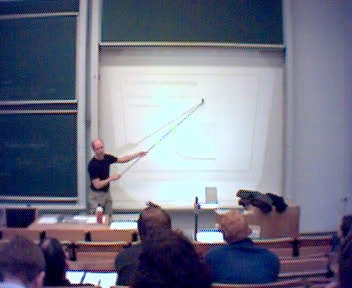
New Year’s Day. The day when everyone makes those resolutions to start dieting, take up more exercise and just generally be a ‘better’ person. Years ago I stopped making those resolutions because I knew, in my heart of hearts, that I would never keep them.
So why was this year any different?
Searching on Twitter (I know!) for ideas about the role of creativity in learning and teaching, I came across the account for 64 Million Artists and decided in a mad moment to sign-up for their January Challenge. Still haven’t really unpacked what prompted that impulse, but I’m glad that I did.
Put simply, you get an email to your mailbox every day throughout January outlining a different creative challenge. You do, then think, then share.
Over the month I have, amongst other things, compiled a picture of the year ahead, made a junk sculpture, danced myself silly (nothing new there!), documented my day through taking a photo every hour (goodness my life is boring!), carried out a random act of kindness and, written a story a line at a time in partnership with fellow Lacunae blogger, Natasha.
I won’t claim to have completed all the challenges. But I had a go at most of them. You can see my responses to the challenges, and those of many others, on Twitter via #64millionartists.
So what did I take away from this experience, and how is it relevant to learning and teaching?
Do

It’s amazing how much time you can spend thinking and writing about creativity, and yet not actually do any creative activity beyond the thinking and writing.. I think this can be a real issue when working as an academic developer. I have certainly spent more time showing people how to make rich pictures and explaining the theory behind them than I have ever spent doing them myself.
Putting aside 20 minutes a day to complete the challenge, and allowing myself some more time if I was enjoying the activity, was a real treat. And I did feel like I had achieved something everyday. I don’t consider myself to be any good at certain types of creative activities but I am quite competitive, so turn the activity into a challenge and I’ll give it a go!
I think this points to the first take away message from this challenge. Having a go was what mattered. And having someone else telling me what it was I had to have a go at gave me permission to not be very good at it.
As teachers do we give ourselves time to do something each day (or even each week!) that we might not be very good at? By this I don’t mean the ‘worthy’ activity of identifying areas for CPD and working on them. I mean just having a go at something where the outcome itself is of little consequence. Given we are all so time poor, it isn’t surprising if we don’t. But perhaps we should.The actual ‘doing’ bit of the tasks, which in many cases involved very tactile experiences, felt very satisfying. This was definitely more about process than outcome.
And it is that focus on process that might make this a very useful learning tool when students can be so very focused on outcome. It’s difficult to introduce tasks into learning and teaching that aren’t directly related to the context of their desired outcomes (their qualifications) – “If it doesn’t count towards their grade, they won’t do it”. And because of this we do take the time and effort to try and contextualise activities that don’t involve direct scored assessment by explaining how they might help them do better in that type of assessment. Once again we drag their thinking back to outcome rather than process.
But what if we didn’t try and do this contextualisation? What if we just provided a short, sharp bit of creative ‘doing’ each day? Would they do it? They might if it were fun!
But why would we, as teachers, bother?
Think

Now you don’t need me to reiterate here all the arguments about the role of reflection in and on learning – hopefully we can all agree that this is a ‘good thing’. But it is not always easy to get students to engage in reflection in a consistent and constructive way. In order to somehow structure the activity we provide templates or series of questions that require a response.
Perhaps we should think about how we can use a much more ‘free association’ approach (going all Freudian!) to encouraging the development of these particular academic muscles. The prompts given by the 64 million artists team were What was it like? Did you enjoy the experience? Did it feel difficult?
The qualitative researcher in me baulks at the inclusion of some closed questions as a prompt for reflection, but actually I found they worked well. When short of time or feeling a little alienated by any of the activities, I could respond quite simply no/yes, but often I found that afterwards the question of ‘why that response?’ spent time percolating through my thought processes. Sometimes even eliciting more sophisticated responses! At other times I felt I could just stick with the no/yes response with no need to justify my response in any way.
Might students, especially those only just beginning to shape their academic identities, find this a more engaging prospect when compared to the more directed reflection we tend to offer them?
Share

Sharing your thoughts and reflections – always a ‘deep- breath’ moment! The focus here was on sharing the feelings and thoughts about doing the activity rather than sharing whatever you had produced. Again, process rather than output. Lots of people did share what they had produced, however, and I found that sharing very affecting.
You could share via a project space on the 64 million artists website, or via social media. Mostly I engaged via Twitter, and as the month progressed I felt a real sense of community developing.
I have been reading and thinking a lot recently about student self-efficacy and resilience. And I keep returning to a piece of work that Simon Cassidy wrote about on the HEA learning and teaching blog. Specifically, the issue that students who are more resilient for themselves also have the potential to support the development of other students’ self-efficacy and, as a result, their resilience. As Simon points out, this has encouraging implications for peer-led learning and mentoring.
Again, there is a tendency to formalise this type of learning and mentoring, but is there space for a much more fluid engagement in a learning community? One of the things that struck me about the January Challengers that shared via Twitter was just what a diverse bunch we were. In most instances the only connection was participating in the challenge, but that connection still enabled learning from each other, and a supportive and encouraging space.
One aspect I include in workshops I facilitate that focus on providing learning and teaching beyond time and space is the need to provide opportunities for learners, who may never meet face-to-face, to create a social space for peer-support. In my work as a tutor with the Open University that space was a ‘Cafe’ forum within the module space on the VLE.
Interestingly, during the rounds of introductions that characterise the beginning of the module students seem to want to be able to situate each other both in terms of space and time. Contributions usually started with “Hello my name is xxx and I live in xxx”. Subsequent discussions – discussions where people were continually presenting and (re)presenting their identities – usually included some elements relating to the the contexts in which they were attempting to study.
But these spaces, confined as they were within the VLE and linked to specific modules, were formally informal! Is there the potential for students to come together around a theme like creativity and an aim like completing the challenges to develop a learning space that encourages peer learning and support? Would that space be the richer for having students from different disciplines and at different stages of their academic careers contributing?
More questions than answers there! I’d love to hear your thoughts – or to hear about any similar strategies you already have in place.
So, the January Challenge is done and dusted, but I have signed up for the Friday Challenge – a creative challenge sent to your email box every Friday. Why not join up and join in? http://64millionartists.com/pledge/







